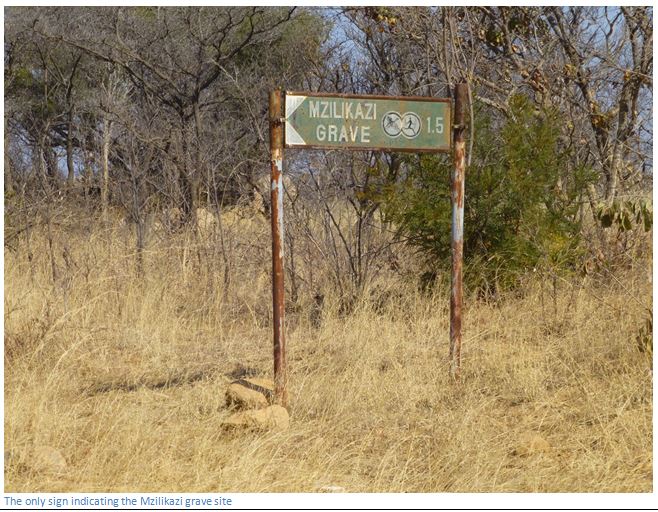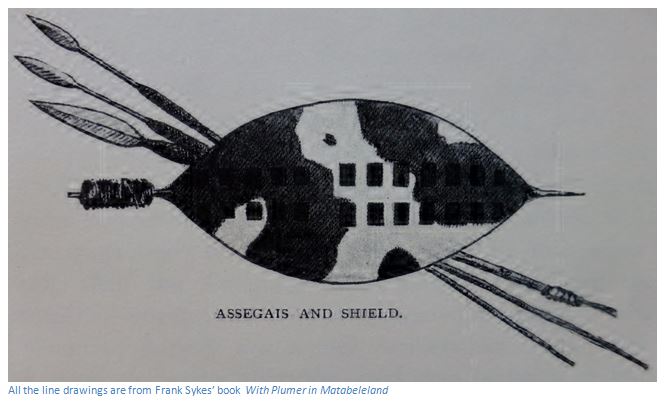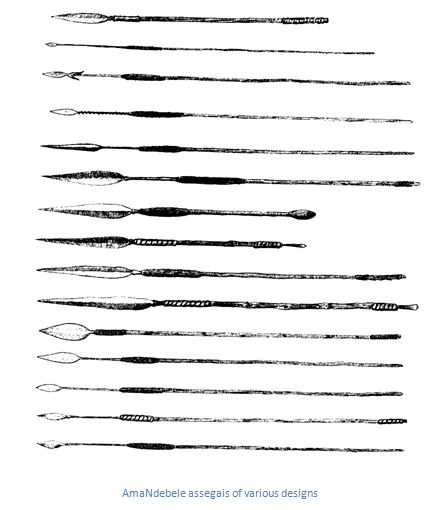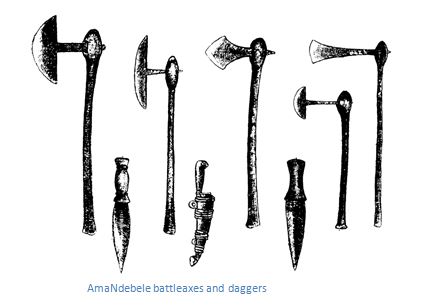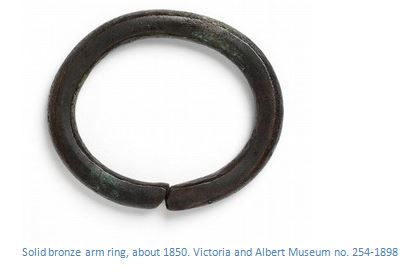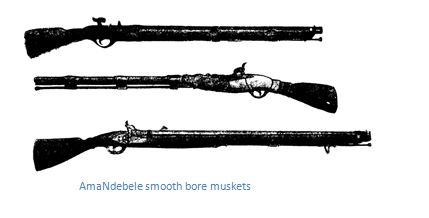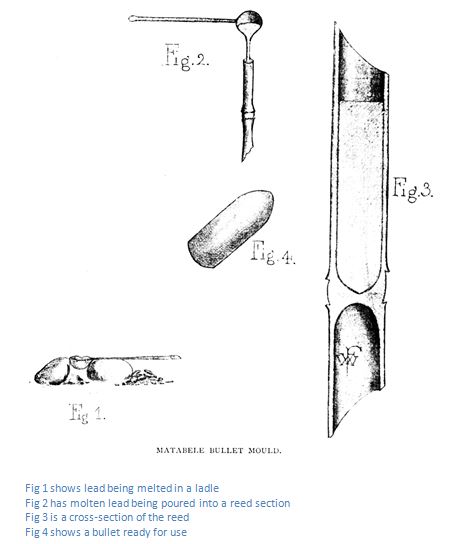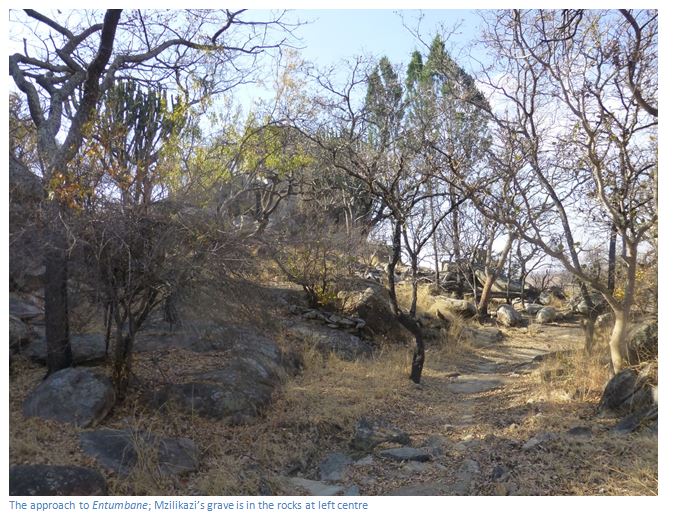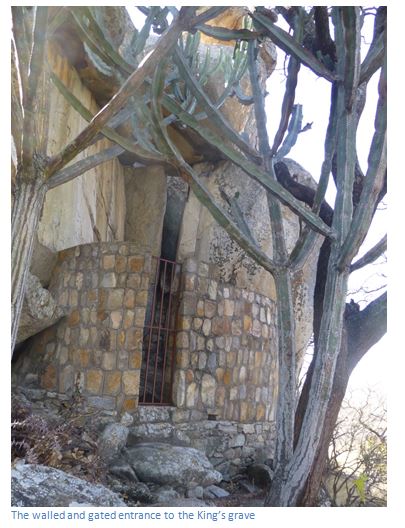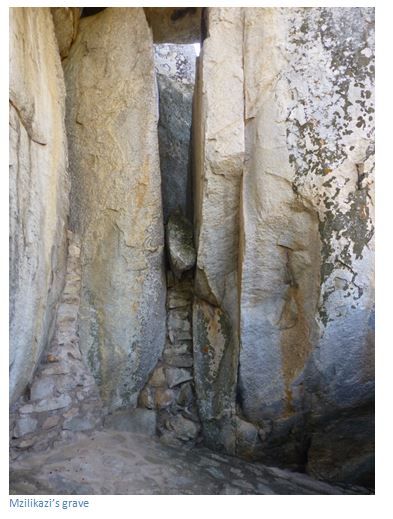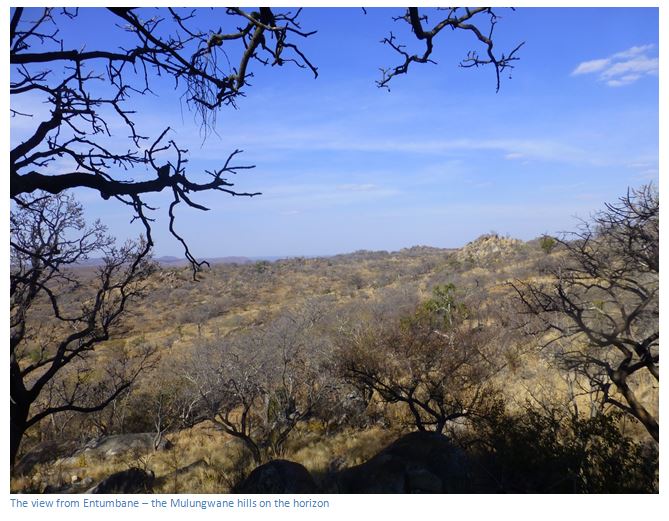Mzilikazi's Grave
Mzilikazi Khumalo is often called the father and first King of the amaNdebele.
Within a few years of Mzilikazi’s death an out of control bushfire during Lobengula’s reign burnt the wagons that had been placed in a cave near to Mzilikazi’s burial cave for which its guardians paid dearly.
His grave site at Entumbane was robbed at some early date and then walled and protected by a metal fence probably in the 1960’s; but too late to protect the important artefacts and relics that it had contained, as the reference to the brass arm ring donated to the V&A museum in 1896 illustrates.
An account of the robbery of Mzilikazi’s grave is given in J.G. McDonald’s book Rhodes a Life.
From Bulawayo take the Matopos road and then take the Old Gwanda Road. Distances are from the Matopos / Old Gwanda road intersection. At 14.5 KM pass the Mzilikazi Memorial on your right, at 21 KM pass some granite outcrops. At 21.8 KM a small National Monuments sign on the right (photo below) indicates the Mzilikazi gravesite. Go through the gate on the left, remembering to shut the gate after you, and follow the farm track, after 500 metres bear left at the entrance to some kraals and follow the track north. After another 400 metres bear left and park in the next 50 metres. You will see some conifers and abandoned huts where the custodian used to stay a few metres to the north.
Follow the footpath which goes east for 300 metres before descending down steps into a shallow valley. Walk another 50 metres and see the gravesite on your left in the cleft of the granite behind some conifer trees. The grave itself is not accessible and is protected by a metal fence. Visitors should remove hats and behave in a respectful manner in the vicinity of the gravesite which is of great amaNdebele cultural importance.
GPS reference: 20°22'40.6"S 28°35'24.4"E
For a summarised account of Mzilikazi’s life see the article on the Mzilikazi Memorial under Matabeleland South on the website www.zimfieldguide.com
Below is a time line of the sequence of events, particularly in relation to the sites of the king’s kraal over the years and is a recap of the article KoBulawayo, or Old Bulawayo (1870 – 1881) and the Indaba Tree under Bulawayo on the website www.zimfieldguide.com
1837 | The Ndebele are defeated at battles of Mosega and Dwarsberg by the Griquas and the Zulu under General Ndlela. The Ndebele nation leaves present-day South Africa divides into two groups: one led by Induna Gundwane Ndiweni made up of women and children and some of the amaNdebele regiments move into Zimbabwe in 1838 and the other, led by Mzilikazi with the fighting men go northwest into Botswana and then North to the Zambezi. |
1838 | Gundwane Ndiweni sets up the first of the four capitals around modern-day Bulawayo. The first capital Gibxhegu is at Esigodinin, near present-day Falcon College. Believing Mzilikazi is dead, they appoint Nkulumane as King. |
1840 | Mzilikazi returns and purges the leaders at Ntaba YeZinduna, including the killing of Faluta, Lobengula's mother and destroys the kraal at Gibxhegu, but Lobengula survives. Mzilikazi marries Nyamazana which unites the Swazis with the Ndebele. A second capital is established at Mahlokohloko, north of modern Bulawayo and later, a third capital is established at Inyathi. |
1863 | Mzilikazi establishes a fourth capital at Mhlahlandleia, on the edge of the Matobo Hills, possibly because he wishes to distance himself from the mission Station at Inyati. |
1868 | Mzilikazi dies and there being no heir apparent, a Regent Mncumbatha Khumalo is appointed. Some Ndebele, including the Zwangendaba Regiment under Mbiko Masuku hope Nkulumane is still alive in South Africa and oppose Lobengula. A bloody fight ensues, from which Lobengula's forces emerge victorious. |
Mzilikazi died on 5th September 1868 following a long period of ill health, but his death was kept a secret by his chief councillors and some of his queens who were with him at Emanxiweni. A cart was brought at nightfall and the King's body was placed in it and taken to Mhlahlandlela where on the 9th September his death was revealed to the amaNdebele nation.
For two months the King's body lay in the royal dwelling guarded by twelve queens and after prolonged ritual ceremonies, the burial process started on 2nd November. Black oxen were sacrificed to the spirits of the dead king and his ancestors. The King's body and his personal belongings were placed on two wagons and taken to a hill named Entumbane on the north eastern edge of the Matobo Hills and a few kilometres east of the Old Gwanda road. On 4th November the body was placed inside a granite-walled cave which was sealed with stones. The wagons were taken to pieces and laid in another cave nearby with his possessions including clothes, utensils, sleeping mats, beads, ornaments, such as the arm ring referred to below; furniture and muskets were placed in another cave.
Armed warriors stood on guard at the entrance to the cave as the mourners moved away and returned to the amaNdebele capital at Mhlahlandleia. The guards and their families built a small kraal close to the grave and settled there as custodians of the sacred spot. It was their duty to see that the grave was not disturbed. But when they burnt the high grass to prepare the ground for their sowing, a wind arose that sent the uncontrolled fire up to the kopje and the flames licked at the King's grave and burnt his dismantled wagons. When the new King Lobengula heard of this mishap, he ordered the instant destruction of all in the kraal at Entumbane; even the dogs and chickens were slain.
Subsequent to writing the above I came across a series of oral history articles collected by Foster Windram when he was a journalist at the Bulawayo Chronicle. One of them is an account by Mvumi, son of Masunke, of the family of Mambo which was made at Fort Usher on 11 November 1937 with the interpreter Dennis Moyle.
The Burning of Mzilikazi’s grave
It happened in the early morning. It happened a long time before Lobengula moved his kraal from old Bulawayo to the place where Bulawayo is today. The removal took place at the time that Carnegie was married. The old Bulawayo was on the Fort Usher road. Lobengula had a cattle kraal at Umvutcha. None of his wives lived there.
Sopeju had been appointed to look after the grave. He was a Msuto by birth and the people living round there were Msutos. They were known as the Amankandhla [Amakhandlela?] They were a mixture of amaNdebele and Msuto.
At about 9pm or 10pm we saw flames. They were still far from the grave. The Inqama [Iqama] regiment started out to put the fire out. I was with the Inqama regiment, this was before I joined the Ineijo regiment. When they had finished putting the fire out, the Amashlope came from Mhlahlandlela. Lobengula was at his old kraal at Old Bulawayo. When the Amashlope arrived, the fire had not caught the grave yet. In the night, when everyone was asleep, a man by the name of Zimba set the fire going again. There was trouble between Zimba and his brothers. They were quarrelling over seniority. Zimba wanted to get those other brothers of his killed. He thought they would get the blame.
Again, the Inqama were there first and the Amashlope followed. The fire was very hard to put out and when they failed to put it out, two men were elected from the Inqama and two from the Amashlope to go and tell the whole story to Lobengula. The grass all around the grave of Mzilikazi had been burnt though the grave itself was in a cave. It was a serious matter.
When Lobengula heard of this, he sent out some executioners to attack the people living in this area. The first original cause of the fire is not known. The isanusi made enquiries and discovered that Zimba had set the fire going again, and then Lobengula sent the executioners. Zimba had his own kraal and his brothers had their kraal, so the executioners divided into two sections, one to Zimba’s kraal and one to the kraal of Zimba’s brothers. All were killed with assegais. They belonged to the Inqama regiment.
I was not there at the time they were killed. Late in the afternoon I set out to go to the Inqama kraal. I went to look for some girls. While there we heard guns and one of the sub-Chiefs, Mazuca warned us to do nothing and remain where we were. About thirty sons of Mazendu were killed that day; Mazendu was the uncle of Zimba. There were six in Zimba’s kraal and all were killed. I lived in a kraal nearby. My mother was one of the Zimba family, which was known as the Inshlwa family. The Inshlwa family consisted of about forty, of whom about four died during the Zwangendaba war, so that there were about thirty-six left. All were killed. Zimba had five people with him who had gone off with him to build a kraal by themselves.
After this execution had taken place, a great impi went to Entumbane [Mzilikazi’s gravesite] and there was a great feast and many cattle were killed. About five black oxen and five he-goats were killed and put near the grave. There was a feast the whole night, but they didn’t touch these five goats and five oxen. The following day we had to eat the five goats and five oxen. On the day after that we collected the bones. The meat was not supposed to be taken home. It had all to be finished there and all the bones were burnt to ashes. Then the impi were dismissed, after staying four days, they were dismissed on the fifth day.
The robbery of Mzilikazi’s Grave
Soon after the first Indaba Rhodes was camped in the Matobo with Jack Grimmer his secretary, Hans Sauer, Johan Colenbrander, as guide and interpreter and James McDonald who wrote an account of the robbery in his book Rhodes: A Life. Plumer’s headquarters staff rather resented Rhodes’ attempts to negotiate with the amaNdebele in the Matobo so the small party had initially camped about eight kilometres northeast of Plumer’s main camp on the northern edge of the Matobo, but after the first Indaba they moved southwest and into the Matobo hills. Rhodes thought the amaNdebele would be more willing to visit him if there were no soldiers around. Carrington and Plumer objected and said they would be blamed if Rhodes’ camp was overrun, but Rhodes managed to persuade them this would not happen.
A few days later Colenbrander was called by two amaNdebele headmen who told him that troopers under General Frederick Carrington’s command had broken into Mzilikazi’s grave, dug up the ground and removed objects as well as breaking into the nearby cave in which were stored the King’s personal belongings and taken many objects away.
The two headman were very afraid that the spirit of Mzilikazi had been disturbed and that the amaNdebele would believe the sacrilege had been deliberately carried out by Carrington’s Matabeleland Relief Force. They added that a party of ten were coming to discuss the matter with Rhodes the next day.
Rhodes and Colenbrander were extremely perturbed and immediately saddled their horses and rode over to Plumer’s camp. An inquiry was begun; a party of troopers had been given permission to go shooting and admitted to robbing Mzilikazi’s grave. Steps were immediately taken to deal with the offenders, McDonald does not say what they were and Rhodes and Colenbrander returned to their camp.
The two headmen were sent to the chiefs to tell them that everything possible would be done to repair the damage and Rhodes himself would go with the Chiefs to Entumbane.
The chiefs arrived in the morning very angry and after eating food with Rhodes set off for Entumbane about ten kilometres away over difficult ground as there was no footpath. Herbert Taylor, the newly appointed Native Commissioner arrived at the camp and joined the group. Many amaNdebele had congregated at Entumbane, some were armed and agitated.
Rhodes asked everyone to move into an open spot where he could address them through Colenbrander. He asked the crowd for calm and said he would accompany the chiefs to view the damage himself and that everything possible would be done to put things right and if they waited an hour he would return and address them again.
The party including McDonald at once set off for the gravesite, which as can be seen from the photographs enjoys great views over the Matobo hills to the west and the Mulingwane Hills to the east. He saw seven or eight great granite boulders standing upright; inside which Mzilikazi was sitting upright in a stone chair. The three entrances had been filled with broken granite stones, but two had been pulled down. A circular granite wall around the tomb had also been knocked about with holes dug in the ground…presumably the thieves had hunted for treasure.
Fortunately Mzilikazi’s body had not been much disturbed and Rhodes asked the chiefs how things could be put right again. Before they replied they said they should all visit the large cave on the south west of the hill where the King’s personal possessions had been stored. The walled entrance had been broken down and the contents inside the cave had been strewn about. There were broken wagons, carriages, furniture, crockery, and glassware given to Mzilikazi over many years scattered about with many items smashed.
Rhodes was extremely angry at the destruction and discussed the situation with Colenbrander and Taylor. The chiefs walked back to the waiting crowd and spoke to them before Rhodes’ party was asked to join them. They told Rhodes that they were satisfied that he had no hand in the destruction; that it was a shameful action carried out by a few rogues and that if the proper sacrifices were made, all might be well with the spirit of Mzilikazi.
The amaNdebele themselves would rebuild the grave and cave walling; Rhodes should provide food for the men engaged in the work and after the purification ceremony at the gravesite, ten black oxen should be sacrificed to the spirits of Mzilikazi. Colenbrander and Taylor made short speeches expressing their regret at what had happened.
Three weeks later the work was complete, the walls rebuilt and the gravesite sealed, Rhodes and McDonald revisited the site and another ten oxen were given by Rhodes for a feast when all the ceremonies had been completed.
The bronze arm ring in the photo below came into the Victoria and Albert Museum’s possession in 1898.
The letter below from the V and A’s accession register reveals how it made its way into the collection:
“69 Eaton Terrace / Jan. 18 1898 / Dear Mr Clarke, I am sending by the bearer who brings this a small parcel, containing a bangle, the history of which is that it was taken off the skeleton of Moselekatze (I think that is how the name is spelt) when his grave was opened. Some buttons which were recently exhibited in the Museum of Bulawayo were found at the same time. The bangle contains a certain percentage of gold and I was told resembled the metal used for ornaments by the Phoenicians; of this you will be a better judge than I am. I can vouch for the authenticity of the bangle as it was given me when I was at Bulawayo in [18]96 by the man who opened the grave. I shall be very glad to give it to the Museum, if you consider it worthy. / yours truly, F.A. Fortescue.”
Colonel Francis Alexander Fortescue had a very distinguished military career (see the website http://www.thepeerage.com/p29684.htm#i296836) and fought in the Boer War from 1899 – 1900 and was mentioned twice in despatches and was promoted to Colonel when on the General Staff in South Africa. It appears he made the purchase on a short visit to Rhodesia.
Presumably one of the troopers present when Mzilikazi's gravesite was robbed kept the bronze ring as a keepsake and it eventually was purchased by Col. Fortescue in Bulawayo.
On 9th June 2016, the Chronicle reported that a gold coated spear belonging to King Lobengula, a black fly whisk and a small brown clay pot were stolen from the National Museums and Monuments of Zimbabwe (NMMZ) exhibition site near Old Bulawayo, so the theft of artefacts does not appear to be just an historical problem.
In addition there have been calls from Peter Zwidekalanga Khumalo that the grave of their ancestor, Mzilikazi Khumalo, has been neglected by NMMZ and is in a state of disrepair. Indeed, on my August 2016 visit, the signage was poor and I did not encounter a single person in visiting the Entumbane grave site. His accusations that the present Government has a policy of downplaying the significance in the national identity of Mzilikazi’s legacy in the history and culture of modern day Zimbabwe has a distinct ring of legitimacy about it.
The response from NMMZ that the grave is maintained according to the Khumalo traditions and in fact, “belongs to the Khumalo’s” appears to verge on the disingenuous, and lacks honesty and sincerity as the site is National Monument No. 41 of Zimbabwe and not a Khumalo family possession.
Acknowledgements
The above oral statements were taken by Foster Windram, with the help of Denis Doyle, when he was a journalist at the Bulawayo Chronicle in 1937 with those persons in their home kraals who had personal knowledge of the events that had taken place; there are copies at The National Archives of Zimbabwe (CR 2/1/1) / Bulawayo Library and with Alan Windram.
http://www.vam.ac.uk/content/articles/a/arm-ring-of-an-african-leader/
http://www.chronicle.co.zw/lobengulas-spear-stolen/
J.G. McDonald. Rhodes, A Life. Books of Rhodesia. Bulawayo, 1971

